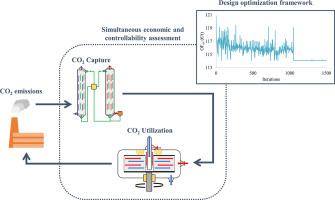CO2 capture and utilization for production of precipitated calcium carbonate in a rotating packed bed: simultaneous design and control using distributed computing
IF 3.9
3区 工程技术
Q3 ENERGY & FUELS
Chemical Engineering and Processing - Process Intensification
Pub Date : 2025-08-11
DOI:10.1016/j.cep.2025.110509
引用次数: 0
Abstract
A novel design optimization approach is presented for the integrated CO2 capture (CC) and utilization (CU) process design with simultaneous economic and controllability assessment. The CC process accounts for multiple solvents and process flowsheet options. The CU process targets the production of nano-sized precipitated calcium carbonate (PCC) using a rotating packed bed (RPB). The algorithm enables parallel computing and uses the approximate computing techniques of memoization and task dropping. It is implemented considering 20 alternative options for the CC process, as combinations of 4 solvents with 5 process flowsheet configurations. The tailored CU process is designed simultaneously with the aim to identify combinations that exhibit high economic performance both in steady state operation and under variability. The algorithm is tested in two case studies with different flue gas characteristics and different yearly operating scenarios, exhibiting excellent scalability in 100 parallel threads. The results showed that 2-(2-hydroxyethylamino) ethanol (DEA) is the optimal choice in both case studies. An absorber with intercooling (ICA) increased the driving forces in the CC process and led to better performance in both cases. The optimal design in the case of higher CO2 content in the flue gas involved a double-side stripper (DSS) for solvent regeneration.

在旋转填料床中生产沉淀碳酸钙的二氧化碳捕获和利用:使用分布式计算的同步设计和控制
提出了一种具有经济性和可控性评价的CO2捕集与利用一体化工艺设计优化方法。CC工艺涉及多种溶剂和工艺流程图选项。CU工艺的目标是利用旋转填充床(RPB)生产纳米级沉淀碳酸钙(PCC)。该算法支持并行计算,并采用记忆和任务丢弃的近似计算技术。它的实施考虑了CC工艺的20个备选方案,作为4种溶剂和5种工艺流程配置的组合。量身定制的CU工艺同时设计,目的是确定在稳态和可变工况下均表现出高经济性能的组合。该算法在两个具有不同烟气特性和不同年度运行情景的案例研究中进行了测试,在100个并行线程中显示出出色的可扩展性。结果表明,2-(2-羟乙基胺)乙醇(DEA)是两种情况下的最佳选择。具有中间冷却(ICA)的吸收器增加了CC过程中的驱动力,并在两种情况下都具有更好的性能。在烟气中二氧化碳含量较高的情况下,优化设计涉及用于溶剂再生的双面汽提塔(DSS)。
本文章由计算机程序翻译,如有差异,请以英文原文为准。
求助全文
约1分钟内获得全文
求助全文
来源期刊
CiteScore
7.80
自引率
9.30%
发文量
408
审稿时长
49 days
期刊介绍:
Chemical Engineering and Processing: Process Intensification is intended for practicing researchers in industry and academia, working in the field of Process Engineering and related to the subject of Process Intensification.Articles published in the Journal demonstrate how novel discoveries, developments and theories in the field of Process Engineering and in particular Process Intensification may be used for analysis and design of innovative equipment and processing methods with substantially improved sustainability, efficiency and environmental performance.

 求助内容:
求助内容: 应助结果提醒方式:
应助结果提醒方式:


